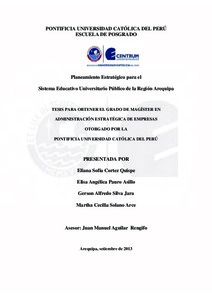| dc.contributor.advisor | Aguilar Rengifo, Juan Manuel | |
| dc.contributor.author | Cortez Quispe, Eliana Sofía | |
| dc.contributor.author | Pauro Asillo, Elisa Angélica | |
| dc.contributor.author | Silva Jara, Gerson Alfredo | |
| dc.contributor.author | Solano Arce, Martha Cecilia | |
| dc.date.accessioned | 2019-03-11T21:50:17Z | |
| dc.date.available | 2019-03-11T21:50:17Z | |
| dc.date.created | 2013-09 | |
| dc.date.issued | 2019-03-11 | |
| dc.identifier.uri | http://hdl.handle.net/20.500.12404/13696 | |
| dc.description.abstract | En el presente documento se analiza el sector educativo universitario público de la
región Arequipa y se plantea ubicarlo entre los cinco primeros sistemas universitarios a nivel
nacional, proponiendo las estrategias necesarias para alcanzar los objetivos que permitirán
alcanzar la visión.
Se realizó un análisis de la educación en los diversos países del mundo, revisado las
políticas y normas que rigen el funcionamiento de los sistemas universitarios, concluyendo
que existe una correlación positiva entre la educación y el desarrollo económico de un país.
Luego del análisis externo e interno se determinó como unos de los factores
determinantes de éxito más importante el incremento de la demanda de profesionales debido
al crecimiento económico del país; la principal amenaza es la deficiencia del sector
educativo secundario como proveedor del sistema universitario. Asimismo, se tiene como
principal fortaleza la infraestructura física y como debilidad más relevante la falta de
acreditación de las carreras universitarias.
El análisis del sistema universitario público se desarrolló tomando como base las
cinco fuerzas de Porter, considerando como referente, el sistema educativo de Finlandia.
Las estrategias planteadas están relacionadas a la producción científica, convenios con
universidades nacionales y extranjeras, prestigio del sistema y acreditación de las carreras
ofertadas por el sistema universitario de la región Arequipa.
Se concluye que el sistema cuenta con un presupuesto que no está siendo ejecutado en
su totalidad debido a la falta de competencia del personal para incrementar los niveles de
investigación científica y mejorar la calidad educativa universitaria pública. Además es
necesario el trabajo coordinado con los grupos de interés a efectos de lograr ventajas
competitivas que contribuya con el desarrollo de la región y el país. | es_ES |
| dc.description.abstract | The present document which does an analysis of the public university education sector
in the region of Arequipa, contemplates its positioning among the top five national university
systems in the country and proposes the required strategies to achieve the aims which would
lead to accomplish the vision.
An analysis of the education in the diverse countries of the world was done,
examining the governing policies and regulations of its higher education systems, concluding
that it exists a positive correlation between education and economic development in a
country.
Afterwards, the external and internal analysis it was determined that one of the most
important determinant factors of success was the increase of demand for professionals due to
the growth of the economy in a country. However, the main threat found was the deficiency
of the high school sector as the supplier of the system. Likewise, as its most relevant strength
we found the material infrastructure and as its main weakness the lack of accreditation of its
university careers.
This current public university system analysis was developed based on Porter 's five
forces, taking as reference the Finnish Education System. The strategies presented are related
to scientific production, agreements with national and foreign universities, prestige of the
system and the certification of careers offered in the region of Arequipa.
Finally, it is concluded that the system has a budget that is not being fully executed
due to lack of the staff competence to increase the levels of scientific research and the
improvement of its quality. In addition, it is necessary to work in coordination with the
interest group in order to achieve competitive advantages that could contribute to with the
development of the region and the country. | es_ES |
| dc.language.iso | spa | es_ES |
| dc.publisher | Pontificia Universidad Católica del Perú | es_ES |
| dc.rights | info:eu-repo/semantics/openAccess | es_ES |
| dc.rights.uri | http://creativecommons.org/licenses/by-nc-nd/2.5/pe/ | * |
| dc.subject | Educación superior--Perú--Arequipa | es_ES |
| dc.subject | Planificación estratégica | es_ES |
| dc.title | Planeamiento estratégico para el sistema educativo universitario público de la región Arequipa | es_ES |
| dc.type | info:eu-repo/semantics/masterThesis | es_ES |
| thesis.degree.name | Maestro en Administración Estratégica de Empresas | es_ES |
| thesis.degree.level | Maestría | es_ES |
| thesis.degree.grantor | Pontificia Universidad Católica del Perú. CENTRUM | es_ES |
| thesis.degree.discipline | Administración Estratégica de Empresas | es_ES |
| renati.advisor.dni | 08246316 | |
| renati.author.dni | 29658290 | |
| renati.author.dni | 29632316 | |
| renati.author.dni | 09661310 | |
| renati.author.dni | 09825938 | |
| renati.discipline | 413307 | es_ES |
| renati.level | https://purl.org/pe-repo/renati/level#maestro | es_ES |
| renati.type | https://purl.org/pe-repo/renati/type#tesis | es_ES |
| dc.publisher.country | PE | es_ES |
| dc.subject.ocde | https://purl.org/pe-repo/ocde/ford#5.02.04 | es_ES |






